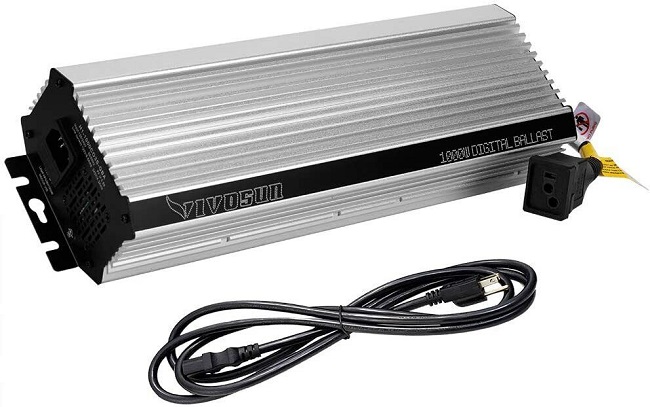
Greenhouse and indoor gardeners rely on artificial light sources to illuminate their gardens throughout the winter months. Whether it is the sole light source or a supplementary lighting system, choosing the proper high intensity discharge (HID) lighting equipment is a process that takes some consideration. Many variables make up a HID horticultural lighting system, from the type of lamp (bulb) to the wattage and voltage of the unit. With new technologies emerging there is also a big difference in the way our HID bulbs are being illuminated. Regardless of the technology, HID lighting units consist of two imperative pieces of equipment: the lamp and the ballast.
The Lamp
All arc-type lamps (florescent and HIDs) can illuminate due to their construction (two electrodes separated by a gas). An arc is the discharge that occurs when the gas contained within the lamp is ionized by an initial burst of voltage. This phenomenon is like the way lightning ionizes the atmosphere due to the significant difference in voltage from the ground to the storm clouds. Once the bulb is struck, the electrical charge excites the gas molecules inside the bulb causing them to discharge photon particles and, therefore, create light. All HID bulbs rely on this discharge of gas to create light, but it is not an instantaneous process. HID bulbs will only produce 5% of their brightness at ignition. Most bulbs require a few minutes of operation before they reach their full light output potential.
The Ballast
A ballast is essentially a voltage controller for arc-type discharge lamps and is required for any HID or florescent light fixture to work. A ballast’s main purpose is to regulate voltage to the lamp for start up and operation. Generally, a ballast will provide higher voltage during the lamp’s start-up and then limit the electrical current during operation to stabilize the arc. If a lamp was directly connected to a constant voltage supply, it would draw an increasing amount of current until either the power supply or the lamp itself failed. The ballast acts as an essential buffer between the power supply and the lamp. The initial burst of voltage to the lamp is known as the strike. There are two types of ballasts available: magnetic and electronic (digital) ballasts.
Magnetic Ballasts
Operation of Magnetic Ballasts
Magnetic ballasts, also known as coil and core ballasts, are the most common ballast used to operate HID lighting. This technology has been around since the early 1900’s and has changed very little in terms of the internal components used. Every HID ballast contains a capacitor and an inductor (the copper or aluminum coils wrapped around the core). A high-pressure sodium (HPS) ballast also contains an igniter, which is required to strike the gases contained within the HPS bulb. A magnetic ballast must be matched to the specific bulb type and wattage to ensure proper operation. HID lamps come in different types (MH, HPS) and different wattages. Each component within the ballast serves a unique function in the striking and operation of the HID lamp. Most magnetic ballasts are multi-tap voltage ballasts and can be rewired easily to operate on a different voltage. Many ballast suppliers offer ballasts that have interchangeable power cords which change the operating voltage and do not require any internal rewiring.
Capacitors
The capacitor’s role is to maintain power to the bulb once it is fired up. Its other important role is to regulate the power to the bulb. Without a capacitor a HID bulb would continue to draw more and more power until the bulb burned out. This is why capacitors need to be rated to the specific wattage of the lamp to operate properly. For example, a capacitor for a 400-watt system will not work in a 1000 watt system or vice versa. There are two types of capacitors used in HID ballasts: wet and dry capacitors. Wet capacitors or oil filled capacitors can be found on some of the older, lower wattage ballasts but, due to the superior performance of dry capacitors, have become virtually obsolete in the horticultural industry.
Dry Capacitors
Most of the ballasts used for horticulture are equipped with a dry capacitor. These capacitors are also referred to as dry film capacitors because of the mylar, polystyrene, polypropylene, polycarbonate, metallized paper or Teflon film used in the internal construction. This film acts as the capacitor’s dielectrics and, because of its resilience to higher temperatures, significantly increases the longevity and reliability of the unit. This is especially important in higher wattage units (600 watts and higher) because they produce significantly more heat than lower wattage units.
Core and Coil
The core and coil within a magnetic ballast is the inductor or transformer that drives the power of the ballast. The core is generally made up of a ferromagnetic metal (a metal that holds magnetism), usually iron or a compound made of other ferromagnetic metals. This core is wrapped with a coil of wire made of copper or aluminum that carries the electrical current. As electricity runs through the coil a magnetic field is created. The presence of the core increases the magnitude of the magnetic field created, sometimes by several thousand times. The main purpose of the core and coil is to create a large voltage boost to the lamp in order to strike the gases contained within the lamp. The electrical current that runs through the coil and increases the magnetic field results in an applied voltage opposite the flow of current in the wire. This is where the lamp is wired in to the ballast to receive this increased voltage until the bulb is struck.
Pros of Magnetic Ballasts
The pros of magnetic ballasts are attributed to the fact that this type of technology has passed the test of time. Light manufacturers have all but perfected this technology, making it a very reliable choice for consumers. So reliable, in fact, that many manufacturers offer 5-year, 10-year, or even lifetime warranties on their products. Magnetic ballasts are also relatively easy to repair so even after a product’s warranty expires it is possible to repair a magnetic ballast for a minimal cost. There are a many magnetic ballast manufacturers which brings forth healthy competition, keeping the price point as low as possible for consumers. Because this technology has existed for so long and there is enough competition between suppliers there is no shortage of options available. A consumer can choose a low cost “bare bones” magnetic ballast kit, a high-end magnetic ballast equipped with all of the top components for a significantly higher price tag or anything in-between.
Electronic and Digital Ballasts
Electronic ballasts are ballasts that utilize electronic circuitry in place of the core/coil, capacitor, and igniter found in magnetic ballasts. The original electronic ballasts were specific to bulb type (MH or HPS), wattage, and voltage. They consisted of little more than a basic circuit board. Since their inception, almost all electronic ballasts in the horticultural industry have been replaced by digital ballasts. Digital ballasts are a type of electronic ballast, and their names are used interchangeably throughout the industry. There is, however, a distinction between digital and electronic ballasts. Digital ballasts are electronic ballasts equipped with a microprocessor that makes various options possible. For example, digital ballasts are considered “smart” ballasts because they will differentiate between a metal halide and a high-pressure sodium bulb. The microprocessor can be programmed to monitor bulb performance and shut down the ballast if a bulb failure is sensed, eliminating continuous attempts to strike a malfunctioning bulb. Microprocessors make it possible to have dimmable, multi-voltage, and multi-wattage ballasts that will even, in some cases, alert the user to problems or any malfunctions. Digital ballasts operate at a high frequency, in the 20,000-60,000 Hz range, which is much higher than the standard 60 Hz operation of magnetic ballasts. This higher frequency creates a heightened level of efficiency for digital ballasts, producing more light per unit of energy consumed.
Pros of Digital Ballasts
The pros of the digital ballast are attributed to technological advancements, allowing for increased efficiency. Because of the way they operate (higher frequency) digital ballasts are more efficient at creating useable light in relation to the energy they consume. Digital ballasts are light weight, significantly smaller than magnetic ballasts and operate very quietly. They also tend to operate a bit cooler than most magnetic ballasts. The digital ballast’s microprocessor allows for soft bulb start-up (a technique shown to increase the longevity of most HID lamps), monitoring of the lamp (which increases safety), and the ability to be interchangeable in terms of wattage, voltage, and bulb type.
Choosing a magnetic or digital ballast is entirely up to the individual and their needs. Each gardener needs to weigh the advantages and disadvantages of both technologies before deciding. Magnetic and digital ballasts serve the same vital purpose: to drive the artificial light source that allows us to enjoy our hobby year-round.
Eric Hopper resides in Michigan’s beautiful Upper Peninsula where he enjoys gardening and pursuing sustainability.
Related Articles & Free Email Newsletter Sign Up
How New Technology Has Changed Grow Lights
Troubleshooting a Magnetic HID Light System




Comment here